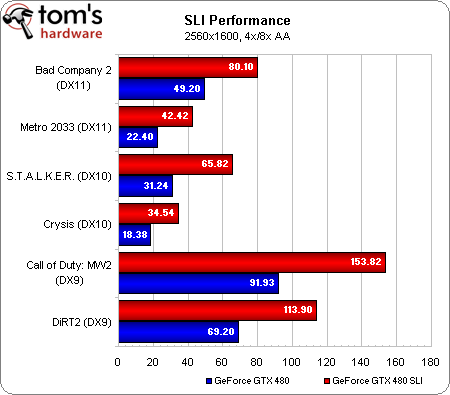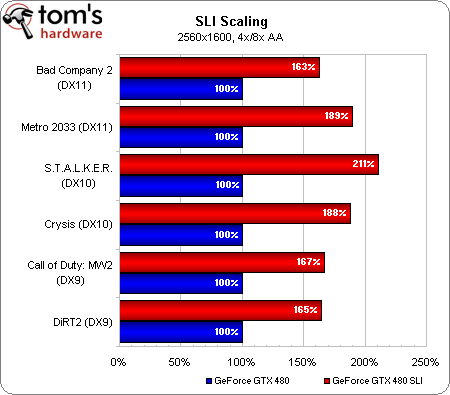GeForce GTX 480 And 470: From Fermi And GF100 To Actual Cards!
Dual-Card Scaling: GeForce GTX 480 In SLI
We were able to get our hands on a second GeForce GTX 480 late in the game for some multi-GPU testing. And although we weren’t able to run the configuration through the complete game suite, we did run Metro 2033, S.T.A.L.K.E.R.: CoP, Crysis, Call of Duty: Modern Warfare 2, and DiRT 2 at 2560x1600 with 4x MSAA and Battlefield: Bad Company 2 at the same resolution with 8x MSAA.
Naturally, slinging a pair of high-end graphics cards makes the most sense to gamers running high-resolution screens. Almost across the board (Crysis is debatable), 2560x1600 with anti-aliasing enabled becomes a very real option. And once 3D Vision Surround becomes testable, you’ll almost certainly want the fastest cards you can get your hands on in order to achieve playable frame rates at, say, 5760x1200 in stereoscopic mode. Last-generation’s cards might be supported, but we're almost positive that they'll be too slow for the quality settings to which enthusiasts have grown accustomed, as scaling between the two cards isn’t expected to be as smooth as what we’ve seen from SLI.
The second chart maps out scaling from one card to two. In the worst-case scenario, SLI yields a 63% speed-up—not bad for a brand new game like Bad Company 2. In S.T.A.L.K.E.R.: CoP, the performance increase is more than double. Yes, we re-ran those numbers; they’re consistent. Despite the degree of horsepower wielded by the latest generation of GPUs, it’s still easy to slam into graphics bottlenecks. A pair of GeForce GTX 480s in SLI shows that at the highest resolutions, a second card can come close to doubling performance—the fastest frame rates you’re likely to see for a while, since power constraints mean it’s unlikely there is a dual-GPU card to anticipate.
Do bear in mind that there are some system builder considerations here. We had two expansion slots between cards on the Gigabyte X58A-UD5 motherboard used for testing. Nvidia recommends that, on boards with three slots available, you use the first and third, leaving room between. In short, GTX 480s back to back is a bad idea. A beefy power supply is a given, though Nvidia hasn’t yet recommended the best wattage for a dual-GPU setup.
Get Tom's Hardware's best news and in-depth reviews, straight to your inbox.
Current page: Dual-Card Scaling: GeForce GTX 480 In SLI
Prev Page Benchmark Results: Battlefield: Bad Company 2 (DirectX 10/11) Next Page Power Consumption And Heat

